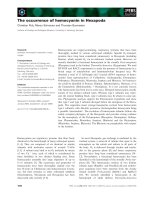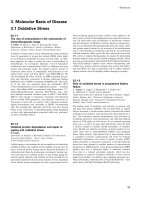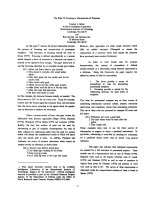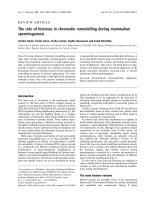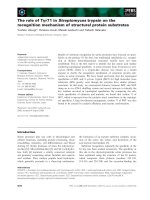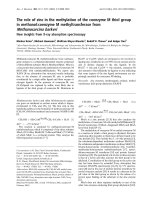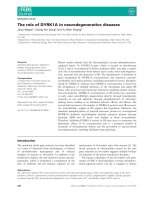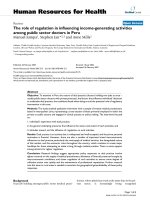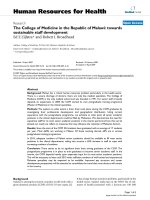báo cáo sinh học:" The role of regulation in influencing income-generating activities among public sector doctors in Peru" doc
Bạn đang xem bản rút gọn của tài liệu. Xem và tải ngay bản đầy đủ của tài liệu tại đây (235.63 KB, 8 trang )
BioMed Central
Page 1 of 8
(page number not for citation purposes)
Human Resources for Health
Open Access
Review
The role of regulation in influencing income-generating activities
among public sector doctors in Peru
Manuel Jumpa
1
, Stephen Jan*
2,3
and Anne Mills
2
Address:
1
Public Health Faculty, Cayetano Heredia University, Lima, Peru,
2
Health Policy Unit, London School of Hygiene and Tropical Medicine,
London, UK and
3
Policy and Practice Program, The George Institute for International Health, Sydney, Australia
Email: Manuel Jumpa - ; Stephen Jan* - ; Anne Mills -
* Corresponding author
Abstract
Objective: To examine in Peru the nature of dual practice (doctors holding two jobs at once –
usually public sector doctors with private practices), the factors that influence individuals' decisions
to undertake dual practice, the conditions faced when doing so and the potential role of regulatory
intervention in this area.
Methods: The study entailed qualitative interviews with a sample of twenty medical practitioners
based in metropolitan Lima, representing a cross-section of those primarily employed in either the
private or public sectors and engaged in clinical practice or policy making. The interviews focused
on:
1. individuals' experience with dual practice;
2. the general underlying pressures that influence the nature and extent of such activities; and
3. attitudes toward, and the influence of, regulation on such activities.
Results: Dual practice is an activity that is widespread and well-accepted, and the prime personal
motivation is financial. However, there are also a number of important broad macroeconomic
influences on dual practice particularly the oversupply of medical services, the deregulated nature
of this market, and the economic crisis throughout the country, which combine to create major
hardships for those attempting to make a living through medical practice. There is some support
among doctors for tighter regulation.
Conclusion: Research findings suggest appropriate policy responses to dual practice involve
tighter controls on the supply of medical practitioners; alleviation of financial pressures brought by
macro-economic conditions; and closer regulation of such activities to ensure some degree of
collective action over quality and the maintenance of professional reputations. Further research
into this issue in rural areas is needed to ascertain the geographical generalizability of these policy
responses.
Background
Dual job holding amongst public sector medical practi-
tioners, where physicians work at the same time in the pri-
vate sector, is increasingly being recognised
Published: 26 February 2007
Human Resources for Health 2007, 5:5 doi:10.1186/1478-4491-5-5
Received: 10 July 2006
Accepted: 26 February 2007
This article is available from: />© 2007 Jumpa et al; licensee BioMed Central Ltd.
This is an Open Access article distributed under the terms of the Creative Commons Attribution License ( />),
which permits unrestricted use, distribution, and reproduction in any medium, provided the original work is properly cited.
Human Resources for Health 2007, 5:5 />Page 2 of 8
(page number not for citation purposes)
internationally as an activity that is widespread and one
which regulators have much difficulty in influencing [1-
3]. Part of the problem is that in many countries there is a
lack of explicit acknowledgement of such activities within
their regulatory systems: e.g. in China there are apparently
contradictory sets of regulations that exist at national, pro-
vincial and hospital levels pertaining to the legality of
such activities [4]; in Canada, there is some ambiguity
about the legal status of private practice per se across prov-
inces [5]; and in Thailand, there are no specific regulations
dealing with this issue [6]. Furthermore, in low and mid-
dle income countries, there is also often a lack of capacity
within government to monitor adequately and imple-
ment the regulations that do exist [3,7].
The motivation for individuals to undertake joint public
and private activity is usually financial and based on the
need to supplement low public sector incomes [2,4,8].
Ethical and legal concerns associated with these practices
often arise because the boundaries between individuals'
public practice and their outside income generating activ-
ities become blurred and consequently such activities are
seen to be prone to corruption or unethical behaviour.
Two commonly cited problems are the misappropriation
of public sector resources and the diversion by a doctor of
public patients into his/her private practice [1,3]. Despite
this, dual practice has also been shown to have positive
aspects. For instance, it provides income opportunities
that potentially enable the retention of qualified person-
nel in public facilities [3,9] and may also increase access
to services [10]. Because of these complexities and the
problem of low regulatory capacity in many low and mid-
dle income settings, crude regulatory responses such as
the banning of such activities are often inappropriate and
ineffective [3].
A central issue relating to the regulation of dual practice is
that it is an activity in which practitioners as individuals
tend to resist encroachments on their personal freedom,
but collectively the profession has a strong interest in reg-
ulation to ensure quality control and prevent oversupply.
This phenomenon is consistent with findings from else-
where [8] and can be characterised as a collective action
problem [11,12]. More intense competition in the market
for medical services in which dual practitioners are oper-
ating tends to exacerbate this discord between collective
and individual interest. In exploring options for appropri-
ate and effective regulation of these activities it is therefore
important to develop options that are acceptable to pro-
viders in order to ensure effective co-operation around
compliance, particularly in settings where there is low reg-
ulatory capacity within the government.
Background
The population of Peru as estimated in the 2005 census
was 26 million [13]. In 1996 there were 9.8 physicians per
10,000 population although the distribution was uneven
across the country. For example, in Lima the rate was 17.3
per 10,000, while in more impoverished areas of the
country such as Huancavelica, Apurimac and Cajamarca
the rates were 2.8, 2.8 and 3.1 respectively [14].
The health system in Peru broadly comprises three sectors:
the Ministry of Health, the Peruvian social security insti-
tute (EsSALUD) and the private sector. Private practice in
medicine has historically been part of the norm in Peru.
Until 1968, Lima's main hospitals were managed by reli-
gious orders and were charitable private institutions. In
1968, the national health system was created: hospitals
were transformed into being part of the national public
health system with doctors within them becoming public
servants [15]. However recent official statistics suggest
that although 66% of physicians are primarily employed
in government institutions, the private sector in physician
services has again become more prominent [16].
In 1996, 39% of physicians were primarily employed by
the Ministry of Health, 18% by EsSALUD, and 32% in the
private sector [17]. It has been estimated that of the
20,000 physicians registered with the Peruvian College of
Physicians, around 10,000 held more than one job [18].
This accords with a more recent survey of over 1000 phy-
sicians across all regions of the country which found that
57% engaged in some form of secondary income earning
activity – 45% of those holding second jobs in the private
sector did so as employees of private clinics whiles 36%
operated solo practices [19]. Nevertheless the capacity of
private hospitals to hire doctors in Peru is constrained by
the fact that an overwhelming majority of all health facil-
ities in Peru (81%) are operated by the Ministry of Health
[14]. Furthermore, there are prohibitions on Ministry of
Health doctors also holding contracts with EsSALUD and
vice versa [18].
Although the regulation of medical practice in Peru can be
traced back to 1888 [15], much of what presently exists
has its origins in the regulatory initiatives that came with
the founding of the Ministry of Health (MOH) in 1935
[20]. Recently, the Medical Working Act was passed to reg-
ulate medical practice in private and public health centres
[21]. As with many countries, however, the regulatory
framework of the health system does not have specific
provisions in relation to dual practice. The Ley General de
Salud (health legislation) states that doctors are governed
by their professional body in providing medical care [22].
The Peruvian College of Physicians Charter 1968 simply
sets out that professionals must observe the ethical rules
of medical practice. The most specific reference to dual
Human Resources for Health 2007, 5:5 />Page 3 of 8
(page number not for citation purposes)
practice is in the Doctors' Working Law 1990 stating the
norms, conditions, hours and salary of Peruvian doctors,
but even here there is some degree of vagueness. This leg-
islation seems to provide some scope for dual practice
through three articles: the 5
th
, 8
th
and 14
th
. Article 5 men-
tions that doctors have freedom to exercise the "medical
act" in whatever circumstances. Article 8 rules that "medi-
cal acts" are: health care, teaching, management, produc-
tion and other activities directly related to the medical act.
Finally, Article 14 indicates that teaching is permissible
simultaneously with health care. The lack of specific pro-
visions dealing with dual practice creates potential for dif-
ferences in interpretation of the regulations.
Against this background, this paper aims through inter-
views with doctors to examine the nature of such activities
in Peru, determine the manner in which individuals are
influenced by prevailing regulatory constraints (or indeed
their perceptions of them), and consider options for being
able to exercise effective regulatory controls over such
activities.
The next section outlines the methods used in the study.
This is followed by a presentation of the results. The
fourth section discusses the broader implications of the
findings (including limitations) and this is followed in
the final section by some conclusions.
Methods
The Peruvian College of Physicians was used as the sam-
pling frame for the study. Although all registered doctors
in Peru are listed on this register, due to financial and
logistical constraints, only those based in metropolitan
Lima were considered. Respondents were sampled purpo-
sively to maximise variation by reflecting a cross section of
those primarily employed in either the public or private
sector; and in clinical practice or policy making. Twenty
respondents in total were interviewed before saturation:
six of the respondents were from private clinics, five from
the Ministry of Health, six from EsSALUD and three were
office bearers within the Peruvian College of Physicians.
The details of each respondent in terms of these affilia-
tions are highlighted in the reporting of results (below).
Doctors were collected from their place of employment,
and interviewed in the Peruvian College of Physicians
building. A one-hour session for each, led by a specialist
in qualitative studies (although the lead investigator was
also present) began with an explanation of the reasons for
the study followed by broad questions related to the doc-
tor's professional activities. A step-by-step approach, from
the easiest to the hardest questions, was used to progress
through the interview stages.
The interviews were built around a series of questions that
focused on three key issues:
1. individuals' experience with dual practice;
2. the general underlying pressures that influence the
nature and extent of such activities; and
3. attitudes toward, and the influence of, regulation on
such activities.
The first and second issues focus on individual behaviour
and motivation and the third was about identifies collec-
tive interests and potential to achieve co-operative out-
comes.
The in-depth interviews were tape-recorded and tran-
scribed in Spanish. The findings were grouped into
themes to address the general issues specified above (and
summarised in table 1). This process was informed by
joint reflections of the interviews from the facilitator and
the lead investigator.
Results
Individuals' experience with dual practice
Many of the interviewees confirmed the common view
that dual practice is widespread amongst public sector
doctors:
Table 1: Summary table of results
Experiences with dual practice Individual motivations Underlying external pressures Policy/regulatory levers
Very prevalent Income Highly competitive market Some in favour of banning
Popular with younger doctors who tend
to be more aggressive
Skills development Macroeconomic crisis and income
pressures
Tighter workforce planning called
for
Legitimacy based on historical
acceptance of DP
Clinical autonomy and access to facilities Deregulation of medical education Adequate public sector income
seen as important in reining in
uncontrolled dual practice
Evidence of misuse of public sector
resources
Lack of career path and income
progression in public sector
Lowering work and pay conditions
associated with competition
Tighter regulation in terms of
quality of care
Favourable outcomes in terms of skills
development
Emergence of quasi-private clinics
within public hospitals
Human Resources for Health 2007, 5:5 />Page 4 of 8
(page number not for citation purposes)
"The vast majority, almost all doctors working in the public sec-
tor, have another job: in their own office or in larger private
clinics" (Policy Maker (PM) #2, College of Physicians)
"It is rare that a doctor has only one job" (PM #2).
In terms of whom typically carries out such activities,
young male doctors are seen to be the most frequent dual
practitioners:
"They are the more aggressive, because they have less opportu-
nities (in their primary jobs)" (Rheumatologist #16, employed
by EsSALUD).
"All doctors have dual jobs, however, junior doctors are increas-
ingly sub-contracted by others" (PM #3, College of Physicians).
"We must divide doctors by generations; the new generation
will have options available. However, I would not give up my
public job" (Paediatrician #9, Ministry of Health).
The main incentive for dual practice is to obtain a better
income. Public employment alone fails to offer a comfort-
able income:
"The main cause of dual practice is the need for doctors to
improve incomes" (PM #2, College of Physicians).
Indeed as a result of such pressures, there were frequent
reports of doctors holding more than two different jobs to
supplement their income.
"In the past 10 years the classical form of dual practice of a pub-
lic job in the morning, doctor's office in the afternoon, has been
declining; the multi-job practice is replacing it" (PM #1, Col-
lege of Physicians).
Another incentive is the ability to foster and maintain
skills in clinical practice. This is very important for junior
doctors:
"Instead of doing nothing at home, or working in non clinical
jobs, I prefer clinical practice out of hours even for a minimal
wage. I am a doctor and I need to be in touch with patients"
(General medicine #,3 private clinic).
Other perceived attractions are clinical autonomy and
access to better equipment:
"The private clinics manage their own budget, updated technol-
ogy and better equipment. This allows the provision of better
health care and provides more professional satisfaction" (Oth-
orhinolaryngologist #1, private clinic).
Lack of a professional career path/development also has
an influence on dual practice. There is the perception that
there is no income progression in the public sector and
doctors thus need to look for other income sources.
"There are no professional careers in public institutions. Hospi-
tal directors are hand-picked; there is no respect for seniority or
postgraduate degrees" (PM #3, College of Physicians).
The factors that impact on decisions as to whether to work
solely in the public sector or engage in dual practice vary
amongst doctors, particularly at differing levels of senior-
ity:
"For senior doctors it is rather more attractive to have profes-
sional improvement and better health equipment in hospitals
than more income" (Paediatrician #8, Ministry of Health).
In addressing the question of why doctors maintain pub-
lic sector employment (rather than working exclusively in
the private sector) a number of reasons were posited. The
income from a job in the public sector was seen to bring
security to doctors by offering a monthly salary and social
benefits (social security, retirement pension, vacations).
This regular income is very important in the insecure
employment market in Peru:
"I wanted to maintain my work at EsSALUD because I needed
experience and because they pay better; at least that is what
matters, isn't it?" (Gynaecologist #2, EsSALUD).
Some expressed a preference for remaining exclusively in
the public sector if incomes could be raised to a level
which met expectations:
"I would leave the private job if my public income would pay the
equivalent of what I earn now doing extra work teaching,
researching and conducting private practice" (Paediatrician
#12, EsSALUD).
Career improvement and professional challenges were
often mentioned in relation to maintaining public
employment:
"It is more intense and challenging working in public hospitals.
You improve yourself. Take public paediatric emergency, or sur-
gery in hospitals: you are dealing with many complex cases and
scarce resources. You are tested to do your best. It is not routine"
(Surgeon #13, EsSALUD).
The public job is, however, also considered a useful plat-
form for incursions into the private sector:
Human Resources for Health 2007, 5:5 />Page 5 of 8
(page number not for citation purposes)
"From my perspective, my public job provides me with social
security; from it I can expand my medical activities" (Derma-
tologist #15, EsSALUD).
"One needs a fixed salary to feel at ease" (Paediatrician #8,
Ministry of Health).
Underlying pressures
Many respondents highlighted various work conditions
including income and other aspects of the workplace as
major concerns for individual doctors.
There has been an increase in competition in the private
sector and this has created difficulties for doctors seeking
to establish private practice:
"The problem is there are many doctors and nobody regulates
the entrance of more doctors" (Gynaecologist #6, private
clinic).
As a result, moving into private practice provides no guar-
antee of financial rewards:
"Private clinics are nowadays working at 30–40% of their
capacity" (Gynaecologist #2, private clinic).
"Establishing a private office is no longer worthwhile. Many of
them are now closing down" (Paediatrician #12, EsSALUD).
"Things have changed, and nowadays clinics such as the Hogar
de la Madre are declining. Doctors are totally exploited"
(Gynaecologist #2, private clinic).
The country's macro-economic situation has had a great
influence in shaping dual practice:
"Due to the country's economic crisis, doctors need to find other
jobs to survive" (PM #3, College of Physicians).
"Doctors do dual practice because of their domestic require-
ments (food, children's education, maintain social status), and
to maintain their quality of life. Other pressures are the eco-
nomic crisis low salaries, fragility of the medical labour sys-
tem (e.g. doctors on temporary contracts do not have social
insurance, do not have professional career incentives); over-
supply of new doctors leads to more competition and lower fees"
(PM #3).
Deregulation of medical education also influences dual
practice. There are an increasing number of newly gradu-
ated professionals:
"In Lima alone there are seven medicine faculties and still
growing" (General Medicine #3, private clinics).
"One of the problems is the excessive number of specialists. That
is because the universities are creating graduates without
matching the country needs. Neither the universities nor the
MOH actually know how many specialists are needed" (Sur-
geon #13, EsSALUD).
Furthermore, deregulation of medical working conditions
has led to a reduction in the number of formally con-
tracted doctors. Increasingly, doctors are employed under
temporary contracts with lower wages and no social insur-
ance:
"Nowadays, being in the medical labour market is precarious;
people cannot rely on social security or progressive income incre-
ments" (PM #3, College of Physicians).
Other factors mentioned are the conditions of work
imposed on healthcare suppliers by insurance companies
and the role of medical corporations in shaping private
practice:
"The insurance companies have imposed abusive conditions on
health suppliers" (Paediatrician #12, EsSALUD).
"Private practice has changed its shape: actually the medical
corporations are filling the market. To operate in private prac-
tice you now have to fit into the corporation network" (Paedia-
trician #12).
Managerial conditions such as the productivity measures
imposed by employers also affect dual practice:
"It is hard to do dual practice when based at ESSALUD facili-
ties because doctors are required to see a large number of
patients per week (averaging around 15 minutes each). How-
ever, it is quite easy to do dual practice at the Ministry of Health
hospitals since they have not introduced such productivity
mechanisms" (Rheumatologist #16, EsSALUD).
Young doctors are particularly affected by the private sec-
tor's financial problems:
"Young doctors wait for an opportunity in the private sector,
though they are then exploited" (General medicine #3, private
clinic).
Attitudes toward, and the influence of, regulation on such
activity
Dual practice is seen to have a degree of natural legitimacy
that is based on an historical acceptance of such activity:
"There always has been dual practice; it is the main character-
istic of medical professional exercise" (PM #1 College of Physi-
cians);
Human Resources for Health 2007, 5:5 />Page 6 of 8
(page number not for citation purposes)
"The dual practice has always existed" (PM #2 College of Phy-
sicians).
The use (or, put more bluntly, misappropriation) of pub-
lic sector resources to subsidise private practice is per-
ceived as a potential problem:
"This is present in public services. Diverse surveys have shown
cross subsidies among the Ministry of Health, EsSALUD and
the private clinics" (PM #1 College of Physicians);
"It [misappropriation] is possible; it has not been well studied;
However, it is possible" (PM #2 College of Physicians).
Some doctors, however, also saw favourable outcomes
associated with dual practice:
"Teaching and clinical practice reinforce each other. Doctors
are updated, patients are seen more carefully" (General medi-
cine #11, Ministry of Health).
Some doctors interviewed criticised the existence of quasi-
private clinics (public facilities that function as private
clinics) inside public hospitals. For example, Loayza Hos-
pital in Lima established such a clinic in 1994 allowing
patients access to private rooms through payment of con-
sultation fees several times greater than those paid by pub-
lic patients. This is used as a means of generating private
incomes and also generates rental income for the hospital
[23]. Though these clinics improve the income of medical
staff as well as generating more hospital revenues, they
create barriers to patients' access to health care:
"Patients should have equal access to public facilities; money
should not establish differences at government facilities these
types of private clinics are encouraging self-interest amongst
doctors" (General medicine #17, EsSALUD).
However, others disagreed:
"The quality of care is the same for everybody, what changes are
the 'hotel' facilities" (PM #2 College of Physicians).
"The quality of care is similar because it is provided by qualified
doctors. What makes a difference is the speed of bureaucratic
procedures" (PM #3 College of Physicians).
There was some support amongst policy makers for ban-
ning dual practice, but also some disagreement:
"Yes, it must be regulated ( ) the state must provide for the
existence of an exclusive public career (PM #2 College of Phy-
sicians)".
"Regulation would be worthwhile if it is linked to developing
exclusive dedication to public facilities" (PM #1 College of Phy-
sicians).
"I do not think it [banning] is necessary. Doctors have a free
right to have a public and a private job. I do not know how we
could regulate it. To start, there is no legal framework to do it.
Secondly, if we are generating a legal framework, we must
address the problem of providing sufficient incomes [in the pub-
lic sector]" (PM #3, College of Physicians).
The state as well as the professional bodies and hospital
boards are perceived as necessary for regulation:
"The state, the Peruvian College of Physicians and the hospital
boards, all of them would regulate dual practice" (PM #3, Col-
lege of Physicians).
"Yes, the Ministry of Health should regulate teaching and clin-
ical practice" (General medicine #3, private clinic).
Income, quality of care and workforce planning were
three areas for regulation identified:
"The principal mechanism for regulation is contracting doctors
for exclusive dedication to public employment and providing
them with an adequate income" (PM #2 College of Physi-
cians).
What should be regulated is the quality of care to patients
hospital boards must do it" (Othorhinolaryngologist #1 private
clinic);
"The College must regulate the number of students on each
medical faculty" (Gynaecologist #2 private clinic).
"The hospital boards must regulate the number of students for
patients, meanwhile the College should regulate the quality of
care because it is related to ethics and morals" (Othorhi-
nolaryngologist #1, private clinic).
Table 1 provides a summary of the findings.
Discussion
There is no explicit reference to dual practice in the health
sector regulations in Peru and thus its legal status is
unclear. Against this background, there is anecdotal evi-
dence highlighting its widespread prevalence. One of the
key aims of this study was thus to examine the nature of
this activity. The main areas of agreement were that dual
practice is seen amongst doctors to be commonplace and
furthermore, widely acknowledged. The motivation for
such activities is typically financial. In terms of why such
doctors continue to maintain their primary roles in the
public sector, the main reasons cited were economic secu-
Human Resources for Health 2007, 5:5 />Page 7 of 8
(page number not for citation purposes)
rity and skills development. Such findings are consistent
with those found in other settings [2,4,6,8]. Where there
was less agreement was in the nature of the regulatory
responses needed around dual practice – some favouring
the banning of such activity while others taking a more
tolerant approach aimed essentially at minimization of
harm.
There are a number of broader features of the Peruvian
context that have not been well explored in the studies
conducted elsewhere. Firstly, the highly competitive
nature of this market in Peru meant that dual medical
practice was not seen as necessarily a guarantor of better
income. One consequence was the commonly reported
need for some to hold more than two jobs. It was found
that that younger male doctors tend to be the most aggres-
sive in pursuing dual practice opportunities. Some of the
reasons cited for why such pressures are prevalent in Peru
were the deregulation of the medical labour market and a
lack of workforce planning leading to too many graduates
entering the profession. Also, poor macroeconomic con-
ditions have lowered incomes and purchasing power of
government employees and diminished their job security.
At present, Peru has an unemployment rate of 9.6% but
this is masked somewhat by an underemployment rate of
54.9% [24]. Although dual practice has historically been a
feature of the Peruvian health care system, such condi-
tions have had the effect of lowering living standards gen-
erally and increasing competition in this market and
undermining individuals' income earning ability.
Another manifestation of these pressures in this market
was the 'exploitative' conditions of work many felt were
imposed by private employers.
Perhaps not surprisingly, against this background, there
was much agreement among medical professionals for
greater regulation of such activities, although less agree-
ment as to who should do the regulating. Some believed
it should be from government while others advocated
some form of self-regulation. One of the key findings of
this study is that options for altering the regulations per-
taining to dual practice need to be tied in with what is
happening in the wider economy and the reforms that
affect it. While there was a view expressed that income
should be the focus of regulation, there was also acknowl-
edgement of the external pressures on the market for dual
practice services and therefore broader regulation of med-
ical education and workforce planning would be consid-
ered relevant. This is potentially important in ensuring, at
least in the long term, that medical practitioners are able
to achieve an adequate standard of living from such activ-
ities and preventing the erosion of quality through unfet-
tered competitive pressures in such markets. The key to
this is in recognizing that the regulatory issues surround-
ing dual practice are about medical practice generally
rather than dual practice as an isolated activity.
An important aspect of regulation is its potential role in
addressing the type of collective action problem created
by dual practices in which the individual short term inter-
ests of practitioners are not necessarily consistent with the
collective interests of the profession. Regulation imposes
certain norms of behaviour that may not be achieved
more spontaneously through the co-operation of individ-
uals. Such regulations would be required to provide
explicit recognition of dual practice activities, specify cer-
tain standards of quality that to some extent could be
enforced in collaboration with professional bodies such
as the College of Physicians, and ensure proper demarca-
tion between activities in the public and private sphere. At
the same time, the aim would be to protect professional
reputation and preserve some degree of market power. A
characteristic of the present situation, as highlighted in
the findings, is the deregulated market in medical practice
and the difficulties associated with earning a living in such
an unrestrained and competitive environment. It has been
found elsewhere that in settings where regulatory capacity
is low, a collusion of interests can seriously undermine the
implementation of a piece of regulation [25]. Therefore
ensuring that regulation is designed so that there is at least
the perception of a 'win-win' situation amongst key stake-
holders can be important in ensuring proper implementa-
tion – particularly where a lack of regulatory capacity is
likely to be a major constraint on government action. In
other words, successful regulation in this area requires the
doctors themselves to want to be regulated. The findings
of this study suggest that such conditions for collective
action exist in this setting.
One limitation of the study is that the findings were
drawn from metropolitan based doctors where it is likely
that competition for the provision of medical services is
most intense. It is perhaps less likely to be so amongst
rural doctors. This may have a bearing on the generaliza-
bility of these findings and therefore, until further studies
are conducted in rural areas of Peru, any policy response
may need to be specific to metropolitan areas rather than
national. The difficulty with qualitative approaches to
studying these issues is that generalizability cannot be
specifically tested. In this study we have tried to ensure
broad coverage of issues by examining the differing per-
spectives generated through our purposive sampling strat-
egy.
Elsewhere it has been found that opportunities for addi-
tional income earning opportunities are better for medical
specialists rather than generalists [6]. This study did not
specifically seek to address whether this was the case in
Peru.
Human Resources for Health 2007, 5:5 />Page 8 of 8
(page number not for citation purposes)
Another limitation of the approach taken is that by exam-
ining only the views of doctors (albeit from different sec-
tors), it provides a somewhat partial perspective of the
phenomenon of dual practice and one possibly clouded
by self-interest. In focusing on this perspective, the study
is not able to address the normative questions relating to
the rights and wrongs of dual practice. Rather, it is a study
more of regulatory scope and seeks to build an under-
standing of the appropriate levers which need to be pulled
in order to effect change in the behaviour of individual
actors. In this sense, it is not a study simply of dual prac-
tice, but of the regulatory context and the regulatory
mechanisms to which various actors respond.
Conclusion
This study highlights the importance of understanding the
broader macroeconomic and regulatory context in which
an activity such as dual practice occurs, in order to estab-
lish an appropriate set of policy options. Regulation of
these activities is problematic without recognition of the
forces that push individuals into them and shape the con-
ditions in which they are carried out. The evidence sug-
gests that there is recognition amongst doctors that dual
practice is a consequence of system issues and that regula-
tory responses thus need to be as far-reaching. In Peru,
some of the options that could be considered are tighter
controls on the supply of medical practitioners, measures
to alleviate financial pressures brought by macro-eco-
nomic conditions, and closer regulation of doctors engag-
ing in dual practice to enforce some measure of collective
action. Importantly, in framing an appropriate and effec-
tive policy response, the study has highlighted the role of
regulation in reconciling the collective interests within the
medical profession with broader policy objectives such as
maintaining staff in the public sector and quality control.
Acknowledgements
This work was funded by the Health Economics and Financing Programme
(HEFP), London School of Hygiene and Tropical Medicine, from its pro-
gramme grant from the UK Department for International Development
(DFID). The authors are grateful to Tamsin Kelk for editing the report on
which this paper is based, Susana Mendoza for leading the interviews and
the Peruvian College of Physicians for their co-operation with the study.
The views expressed in this paper are not necessarily those of DFID or of
those others named above.
References
1. USAID: The Health Sector Human Resource Crisis in Africa: An Issues
Paper Washington: USAID, Office for Sustainable Development; 2003.
2. Ferrinho P, Van Lerberghe W, Fronteira I, Hipolito F, Biscaia A: Dual
practice in the health sector: review of the evidence. Human
Resources for Health 2004, 2:14.
3. Jan S, Bian Y, Jumpa M, Meng Q, Nyazema N, Prakongsai P, Mills A:
Dual job holding by public sector health professionals in
highly resource-constrained settings: problem or solution?
Bulletin of the World Health Organization 2005, 83(10):771-775.
4. Bian Y, Sun Q, Jan S, Yu J, Meng Q: Dual Practice by Public Health Pro-
viders in Shandong and Sichuan Province, China Report to the Health
Economics and Financing Programme, London School of Hygiene and
Tropical Medicine; 2003.
5. Flood CM, Archibald T: The illegality of private health care in
Canada. Canadian Medical Association Journal 2001, 164:825-830.
6. Prakongsai P, Chindawatana W, Tantivess S, Mugem S, Tangcharoen-
sathien V: Dual Practice Among Public Medical Doctors in Thailand Report
to the Health Economics and Financing Programme, London School
of Hygiene and Tropical Medicine; 2003.
7. Hongoro C, Kumaranayake L: Do they work? Regulating for-
profit providers in Zimbabwe. Health Policy and Planning 2000,
15(4):368-77.
8. Gruen R, Anwar R, Begum T, Killingsworth J, Normand C: Dual job-
holding practitioners in Bangladesh. Social Science and Medicine
2002, 54:267-279.
9. Ferrinho P, van Lerberghe W, Julien W, Fresta W, Gomes A, Dias F,
Goncalves A, Baackstro B: How and why public sector doctors
engage in private practice in Portuguese-speaking African
countries. Health Policy and Planning 1998, 13(3):332-338.
10. Health Economics Unit: Mobilising Resources Through Hospital Users
Fees in Bangladesh: A Report on Quality and Ability to Pay Health Econom-
ics Unit, Research Paper No. 4. Ministry of Health and Family Welfare,
Dhaka; 1996.
11. Hardin G: The tragedy of the commons. Science 1968,
162:1243-48.
12. Axelrod R: The Evolution of Co-operation London: Penguin Books; 1984.
13. Instituto Nacional de Estadística e Informática (INEI): Información Socio
Demográfica 2006 [ />]. INEI, República del Perú
(accessed 15 August 2006)
14. Pan American Health Organization: Health of the Americas 1998 [http:/
/www.paho.org/english/HIA1998/Peru.pdf]. PAHO (accessed 15
August 2006)
15. Bustíos C: La Salud Pública Durante la República Oligárquica. Segunda
parte 1896–1933. (Primera versión) Lima: Oficina General de Investiga-
ciones UNMSM; 1997.
16. Peruvian College of Physicians: Official statistics Statistic Records
Office. Lima; 2000.
17. Nigenda G, Machado MH, Castrillon MC, Arroya J: The impact of
health care reform on the professional regulation of physi-
cians in Latin America. In The New Public/Private Mix in Health:
Exploring the Changing Landscape Edited by: Soderlund N, Mendoza-
Arana P, Goudge J. Geneva: Alliance for Health Policy and Systems
Research; 2003:13-34.
18. Mendoza-Arana P: Potential of private practitioners to deliver
public health services in Peru. In The New Public/Private Mix in
Health: Exploring the Changing Landscape Edited by: Soderlund N, Men-
doza-Arana P, Goudge J. Geneva: Alliance for Health Policy and Sys-
tems Research; 2003:60-72.
19. Jumpa M, Jan S, Mills A: Dual Practice of Public Sector Health Care Provid-
ers in Peru Report to the Health Economics and Financing Programme,
London School of Hygiene and Tropical Medicine; 2005.
20. Bustíos C: Perú. La Salud Pública Durante la República Demoliberal. Pri-
mera parte 1933 – 1968. (Primera versión) Lima: Consejo Superior de
Investigaciones UNMSM; 1998.
21. Government of Peru: Decreto Legislativo 559. Ley del Trabajo Médico
Lima; 1990.
22. Government of Peru: Ley General de Salud 1997 [en
ciasalud.com/leygeneraldesaludperu.htm]. (accessed 5 July 2006)
23. Webb R, Valencia S: Human Resources in Public Health and
Education in Peru. 2005, 1: [ />sector/Webb%20Valencia%20Sept%2005.doc]. RECURSO Peru
Project, Policy Recommendations and Summary. World Bank
(accessed 15 August 2006)
24. United States Department of State: Background Note: Peru [http://
www.state.gov/r/pa/ei/bgn/35762.htm#econ]. (accessed 9 February
2007)
25. Muraleedharan VR, Jan S, Ram Prasad S: The trade in human
organs in Tamil Nadu: the anatomy of regulatory failure.
Health Economics, Policy and Law 2006, 1:1-17.
